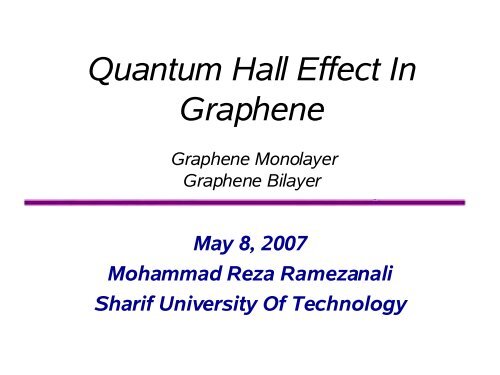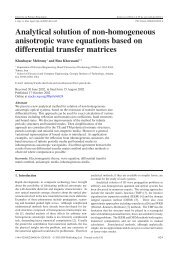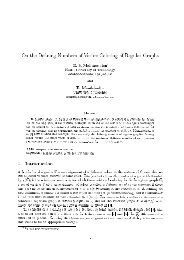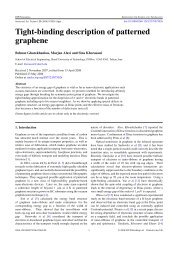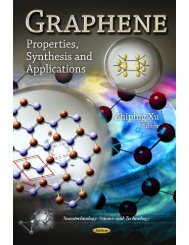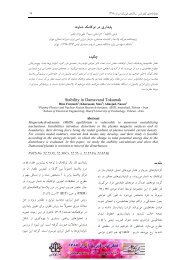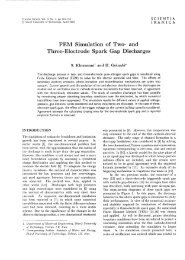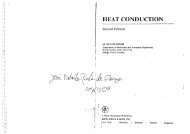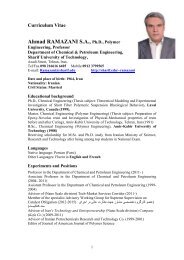Quantum Hall Effect in Graphene
Quantum Hall Effect in Graphene
Quantum Hall Effect in Graphene
Create successful ePaper yourself
Turn your PDF publications into a flip-book with our unique Google optimized e-Paper software.
<strong>Quantum</strong> <strong>Hall</strong> <strong>Effect</strong> In<br />
<strong>Graphene</strong><br />
<strong>Graphene</strong> Monolayer<br />
<strong>Graphene</strong> Bilayer<br />
May 8, 2007<br />
Mohammad Reza Ramezanali<br />
Sharif University Of Technology
Electronic Structure<br />
of <strong>Graphene</strong>
Roughness of undoped <strong>Graphene</strong><br />
N. Abedpour, M. Neek-Amal, Reza Asgari, F. Shahbazi, N. Nafari and<br />
M. Reza Rahimi Tabar, Cond-mat 0705.0103v1 2007<br />
The correlation function of height fluctuations depends upon<br />
temperature with characteristic length scale of ≈ 90 A ° (at room<br />
temperature). They showed that the correlation function of the<br />
<strong>in</strong>duced gauge field has a short-range nature with correlation<br />
length of about<br />
≃2-3A°.
Chiral Fermions <strong>in</strong> <strong>Graphene</strong>
Chiral Tunnel<strong>in</strong>g and The<br />
Kle<strong>in</strong> Paradox
The Kle<strong>in</strong> Paradox<br />
Tunnel<strong>in</strong>g <strong>in</strong> <strong>Graphene</strong> (Top panel) and <strong>in</strong> conventional semiconductor<br />
(lower panel).
The Kle<strong>in</strong> Paradox<br />
Transmission probability through a 100-nm-wide barrier as a<br />
Function of <strong>in</strong>cident angle for s<strong>in</strong>gle- (a) and bi-layer (b) <strong>Graphene</strong>.
Conductivity “Without”<br />
Charge Carriers
M<strong>in</strong>imum <strong>Quantum</strong> Conductivity<br />
Gusyn<strong>in</strong>, PRL 2005<br />
Ziegler, PRB 2005<br />
Peres, PRB 2006<br />
Katsnelson EPJB 2006<br />
Tworzydlo, PRL 2006<br />
.....<br />
Falkovsky Cond-mat2006<br />
Cserti Cond-mat2006<br />
Ziegler, PRL 2006<br />
Ziegler, PRL 2007
Index Theorem and Chiral<br />
<strong>Quantum</strong> <strong>Hall</strong> <strong>Effect</strong>
Quantization Of Dirac Fermion
Quantization Of Dirac Fermions<br />
The prefactor 4 reflects the two-fold sp<strong>in</strong> and two-fold valley<br />
degeneracy <strong>in</strong> the <strong>Graphene</strong> band structure, while the “shift” of 1/2<br />
orig<strong>in</strong>ates from the Berry phase due to the pseudosp<strong>in</strong> (or valley)<br />
precession when a massless (and thus chiral) Dirac particle<br />
exercises cyclotron motion.
Berry Phase <strong>in</strong> <strong>Graphene</strong><br />
• If a quasiparticle encircles a closed contour <strong>in</strong><br />
the momentum space, a phase shift known as Berry’s<br />
phase is ga<strong>in</strong>ed by the quasiparticle’s wavefunction.<br />
• Berry’s phase can be viewed as aris<strong>in</strong>g due to rotation of<br />
pseudosp<strong>in</strong>, when a quasiparticle repetitively moves<br />
between different carbon sublattices (A and B for 1L<br />
graphene, and A1 and B2 for 2L graphene).
Spontaneous Symmetry Break<strong>in</strong>g<br />
A. Spontaneous break<strong>in</strong>g of SU(4) symmetry and<br />
<strong>Quantum</strong> <strong>Hall</strong> Ferromagnetic<br />
B. Spontaneous mass generation and symmetry<br />
break<strong>in</strong>g<br />
C. Electron-phonon <strong>in</strong>teraction and spontaneously<br />
broken <strong>in</strong>version symmetry<br />
D. Edge states and Fractional <strong>Quantum</strong> <strong>Hall</strong> States
BILAYER GRAPHENE
Landau levels and <strong>Hall</strong> conductivity
CONCLUSIONS<br />
“Relativistic” Condensed<br />
Matter Physics
...Thanks...


